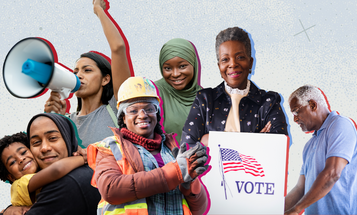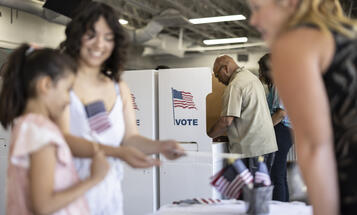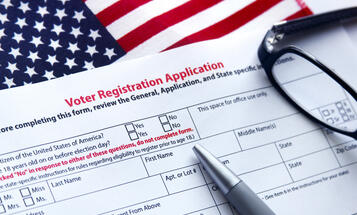
Lessons of 2012: Pushing Back Against Voter Suppression
The right to vote is just that – a fundamental right which is the cornerstone of American democracy. In the 2012 election, that sacred value was challenged in a way we have not seen in a couple of generations, perhaps since the civil and voting rights movements of the 1960s. Some powerful people tried to deny this right; legislatures in many states decided that the freedom to vote should be restricted, and they erected many unnecessary and discriminatory barriers to registration and voting.
The measures taken were so blatant and widespread that they served to energize coalitions of citizens to fight for voting rights harder than ever, and made many voters more determined to vote and have their vote count. The U.S. Department of Justice was compelled to intervene through its powers under Section 5 of the Voting Rights Act, because the laws enacted in several covered states were clearly discriminatory in purpose and/or effect. State and federal courts also struck down or delayed many of the worst of these laws. And where identification laws did come into effect, some were made more flexible and less of a burden on voters after having gone through Department of Justice and court review.
President Obama himself confirmed the need for national attention to protecting the freedom to vote in his acceptance speech on election night, noting the problems that many Americans had faced in attempting to vote, and declaring “we need to fix that.” President Obama is right. His call to action frames both the unacceptable problems that affected the right to vote in 2012 and the need for action going forward to ensure that all eligible Americans can exercise their right to vote.
As I will discuss in a series of blog posts this week, drawing on a new Demos report, the measures to make voting harder for eligible Americans took many forms. Most of them were instigated by Republican-dominated state legislatures which in 2010 and 2011 passed laws that would disproportionately exclude certain groups from the voting process, particularly African Americans, youth and Latinos. It was for obvious reasons: African Americans, Latinos and young people tend to vote for Democrats. And in 2008 these three groups came out in record numbers. So the vote suppression efforts were, unfortunately, focused on demographic groups that historically have been targeted in efforts to restrict voting rights.
The new laws and procedures included strict photo identification and proof of citizenship laws; rules making it harder for former felons to regain their voting rights; laws making voter registration more difficult; pre-election purges of eligible voters; cutbacks on early voting which predictably resulted in unacceptably long lines at the polls; and misuse and manipulation of rules around provisional ballots. Other problems that arose included challenges to voters’ right to vote by organizations connected to or empowered by True the Vote; disregard by state election officials of legal requirements to provide language assistance at the polls; and efforts by groups and individuals to intimidate and mislead voters about voting procedures. There were also new, unanticipated challenges on the East Coast as a result of the damage wrought by Hurricane Sandy.
In the end, however, many of the attempts at voter exclusion went just too far, and backfired on those who would seek to make disenfranchisement an election strategy. Given the strong turnout of the very groups that were targeted, it seems that the American voters were ready to take on this challenge. African Americans matched their record turnout of 2008 and were 13 percent of the electorate. Latinos raised their share -- they were 10 percent of the electorate this year, up from 9 percent in 2008. For all the talk of youth disengagement, the proportion of the electorate under 30 went from 18 to 19 percent. Indeed, just as significant a sign that the tide has turned is the fact that a ballot amendment that would have made photo identification a requirement to vote went down to defeat in Minnesota. At one time the polls showed 80 percent support for the measure. But a strong grassroots campaign to educate the public about the measure turned the tide. As noted in one press report, “volunteers made contact with more than 1.5 million voters over the past four months to explain the costs, complications and consequences of the amendment.” The success of this campaign may be the strongest indicator yet of public opinion turning against these efforts to put up unnecessary red tape around the voting process.
The pushback against vote suppression laws was facilitated by the efforts before Election Day of a coalition of pro-voter organizations and citizens who came together and fought back on efforts to exclude Americans from voting. Restrictive photo ID requirements were blocked by the Department of Justice and/or the courts in Pennsylvania, South Carolina, Texas, and Wisconsin, and vetoed by governors in Minnesota, Missouri, Montana, New Hampshire, and North Carolina. Extreme restrictions on voter registration drives were permanently blocked by the courts in Florida. Cutbacks to early voting were reversed in Ohio. Finally, an Arizona law that required documentary proof of citizenship to register to vote was blocked by the courts.
Moreover, the threats made by True the Vote and its allied organizations to challenge peoples’ rights at the polls turned out to be more bark than bite. Demos and other groups worked to put a spotlight on their misguided and possibly illegal intentions, and relatively few of these threats materialized.
Nonetheless, there was plenty of disenfranchisement and possible exclusion in the 2012 election that will help point us in a new direction going forward: enacting election reforms that expand access to the ballot and create a more inclusive democracy. These measures include Same Day Registration and other reforms to modernize our voter registration system; expansion of early voting to avoid long lines on Election Day; laws to prevent unfounded challenges and other forms of voter harassment and intimidation and greater efforts to ensure Americans who are not proficient in English can exercise their right to vote.


